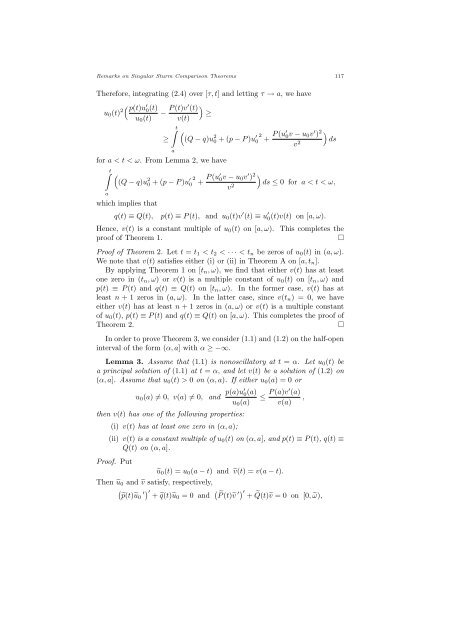REMARKS ON SINGULAR STURM COMPARISON THEOREMS
REMARKS ON SINGULAR STURM COMPARISON THEOREMS
REMARKS ON SINGULAR STURM COMPARISON THEOREMS
You also want an ePaper? Increase the reach of your titles
YUMPU automatically turns print PDFs into web optimized ePapers that Google loves.
Remarks on Singular Sturm Comparison Theorems 117<br />
Therefore, integrating (2.4) over [τ, t] and letting τ → a, we have<br />
u 0 (t) 2( p(t)u ′ 0(t)<br />
− P (t)v′ (t)<br />
)<br />
≥<br />
u 0 (t) v(t)<br />
≥<br />
∫ t<br />
for a < t < ω. From Lemma 2, we have<br />
∫ t<br />
a<br />
a<br />
(<br />
(Q − q)u 2 0 + (p − P )u ′ 2 P (u ′<br />
0 +<br />
0v − u 0 v ′ ) 2 )<br />
v 2 ds<br />
(<br />
(Q − q)u 2 0 + (p − P )u ′ 2 P (u ′<br />
0 +<br />
0v − u 0 v ′ ) 2 )<br />
v 2 ds ≤ 0 for a < t < ω,<br />
which implies that<br />
q(t) ≡ Q(t),<br />
p(t) ≡ P (t), and u 0 (t)v ′ (t) ≡ u ′ 0(t)v(t) on [a, ω).<br />
Hence, v(t) is a constant multiple of u 0 (t) on [a, ω). This completes the<br />
proof of Theorem 1.<br />
□<br />
Proof of Theorem 2. Let t = t 1 < t 2 < · · · < t n be zeros of u 0 (t) in (a, ω).<br />
We note that v(t) satisfies either (i) or (ii) in Theorem A on [a, t n ].<br />
By applying Theorem 1 on [t n , ω), we find that either v(t) has at least<br />
one zero in (t n , ω) or v(t) is a multiple constant of u 0 (t) on [t n , ω) and<br />
p(t) ≡ P (t) and q(t) ≡ Q(t) on [t n , ω). In the former case, v(t) has at<br />
least n + 1 zeros in (a, ω). In the latter case, since v(t n ) = 0, we have<br />
either v(t) has at least n + 1 zeros in (a, ω) or v(t) is a multiple constant<br />
of u 0 (t), p(t) ≡ P (t) and q(t) ≡ Q(t) on [a, ω). This completes the proof of<br />
Theorem 2.<br />
□<br />
In order to prove Theorem 3, we consider (1.1) and (1.2) on the half-open<br />
interval of the form (α, a] with α ≥ −∞.<br />
Lemma 3. Assume that (1.1) is nonoscillatory at t = α. Let u 0 (t) be<br />
a principal solution of (1.1) at t = α, and let v(t) be a solution of (1.2) on<br />
(α, a]. Assume that u 0 (t) > 0 on (α, a). If either u 0 (a) = 0 or<br />
u 0 (a) ≠ 0, v(a) ≠ 0, and p(a)u′ 0(a)<br />
u 0 (a)<br />
then v(t) has one of the following properties:<br />
(i) v(t) has at least one zero in (α, a);<br />
≤ P (a)v′ (a)<br />
v(a)<br />
(ii) v(t) is a constant multiple of u 0 (t) on (α, a], and p(t) ≡ P (t), q(t) ≡<br />
Q(t) on (α, a].<br />
Proof. Put<br />
ũ 0 (t) = u 0 (a − t) and ṽ(t) = v(a − t).<br />
Then ũ 0 and ṽ satisfy, respectively,<br />
(˜p(t)ũ0<br />
′ ) ′<br />
+ ˜q(t)ũ0 = 0 and ( ˜P (t)ṽ<br />
′ ) ′<br />
+ ˜Q(t)ṽ = 0 on [0, ˜ω),<br />
,

















